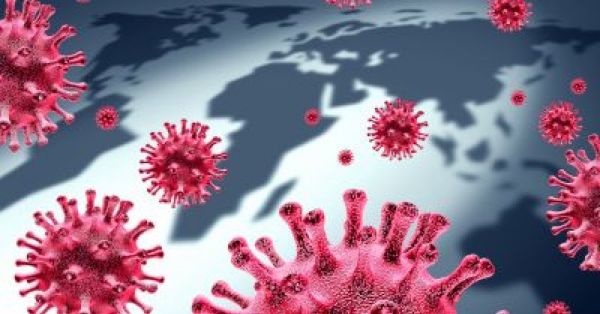The Novel Coronavirus And Nuclear Weapons
As with viruses, containment of atomic weapons may be good, but eradication is best.
by Sergio Duarte , Ira Helfand

The entire international community is justifiably concerned and disturbed with the serious consequences of the novel coronavirus pandemic. Thousands have already died and many more are in danger. Local and national governments find it increasingly difficult to deal adequately with the sanitary and social emergency deriving from the spread of the virus. It will take many months before the situation can come back to normal.
What has this to do with nuclear weapons?
In the current climate of fear, uncertainty and helplessness, it is impossible not to think about what would happen in the case of a different and more ominous disaster: a nuclear conflagration, albeit of limited proportions. The possessors of nuclear weapons are relentlessly increasing the destructive power of their arsenals and seem willing to use them as they see fit to respond to their perceived security concerns. This, in fact, brings insecurity to all. Command and control systems are not immune against cyber viruses and accidents, nor are they protected against whimsical or emotionally unstable rulers.
An all-out nuclear exchange would turn whole cities and vast areas into a flaming inferno. Hundreds of millions of people would perish instantly and many more would die in the following days and weeks from radiation and other harmful effects. The consequences, however, would not be confined to the immense loss of lives, destruction of buildings and transportation networks and disruption of medical, financial and communications systems, as well as other vital structures.
The current year will mark 75 years since the razing of Hiroshima and Nagasaki with the use of just two relatively small explosive devices. Today, the detonation of a mere fraction of the nearly 15,000 nuclear weapons existing in the world would spread millions of tons of smoke, soot and debris throughout the stratosphere and create a dense layer that would surround the planet for many years, perhaps for decades, blocking and absorbing sunlight. This so-called “nuclear winter” would cause extremely low temperatures and other climatic changes, destroying agriculture. The collapse of land and marine ecosystems would make food production impossible. Survivors of such bombings would simply starve.
Humankind cannot remain oblivious of this persisting danger to its own survival.
Three international conferences on the humanitarian impact of nuclear weapons, in 2013 and 2014, concluded that irrespective of its cause, the impact of nuclear detonations will not be limited to national boundaries but would cause deep, lasting and potentially irreversible harm to the environment, human health and well-being, as well as to socioeconomic development and social order, threatening the very survival of our species. Furthermore, no country, group of countries or international organization would be able to deal adequately with the humanitarian emergency resulting from an atomic explosion in an inhabited region.
As long as nuclear weapons exist, the danger of their use will also exist. The only guarantee against such use is the complete elimination of these weapons.
Just as the threat of the new coronavirus must be met by cooperation, common-sense and solidarity among peoples and nations, so must the danger of a nuclear war. In order to help avert such a disaster a comprehensive prohibition of all nuclear test explosions (CTBT) was concluded in 1996, but its full entry into force still awaits signature or ratification by eight states. More recently, in 2017, 122 countries negotiated and adopted a treaty to prohibit nuclear weapons (TPNW). 81 states already signed and 36 have ratified it. Fourteen more ratifications are necessary for it to take effect. As the current emergency inspires us to reflect more soberly about survival risks and threats, the full entry into force of these instruments loom large as urgent unfinished business.
Both those Treaties uphold and reinforce the Treaty on the Non-Proliferation of Nuclear Weapons (NPT), usually considered the cornerstone of the nuclear non-proliferation and disarmament régime. It is fair to say that the NPT has truly contributed to limit actual and prospective proliferators to the current overall number of nine. However, the highest goal that inspires the Treaty—a world free from nuclear weapons—remains unfulfilled.
It may well be impossible to eliminate all disease-causing viruses; yet nuclear disarmament is not only possible, but a legally binding obligation embedded in Article VI of the NPT. Fifty years after the Treaty’s inception, it is high time for the possessors of nuclear weapons to effectively comply with this obligation. As with viruses, containment may be good, but eradication is best.
Sergio Duarte is former United Nations High Representative for Disarmament Affairs and current President of the Pugwash Conferences on Science and World Affairs, the recipient of the 1995 Nobel Peace Prize.
Dr. Ira Helfand is a past president of Physicians for Social Responsibility and serves as the co-president of the group's global federation, the International Physicians for the Prevention of Nuclear War, which was awarded the Nobel Peace Prize in 1985.


 East West Center: NZ Deputy Prime Minister Recounts Longstanding US-NZ Relationship In The Pacific
East West Center: NZ Deputy Prime Minister Recounts Longstanding US-NZ Relationship In The Pacific Global Jews for Palestine: Jewish Organisations' Passover Statement, After 40 Days Of Starvation
Global Jews for Palestine: Jewish Organisations' Passover Statement, After 40 Days Of Starvation APEC: Stronger Immunization Policies Needed As Vaccine Confidence Falls
APEC: Stronger Immunization Policies Needed As Vaccine Confidence Falls 350.org: Indigenous Groups From The Pacific, Brazil & Canada Hand Demands To COP30 Presidency To End Fossil Fuels
350.org: Indigenous Groups From The Pacific, Brazil & Canada Hand Demands To COP30 Presidency To End Fossil Fuels Conservation International: Conservation International Expedition Reveals Ecosystem Recovery In Tokelau
Conservation International: Conservation International Expedition Reveals Ecosystem Recovery In Tokelau UN Special Procedures - Human Rights: UN Expert Urges States To Finance Inclusive And Sustainable Development, Not A War Economy
UN Special Procedures - Human Rights: UN Expert Urges States To Finance Inclusive And Sustainable Development, Not A War Economy